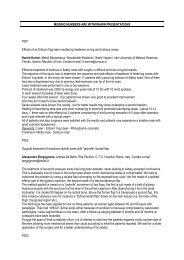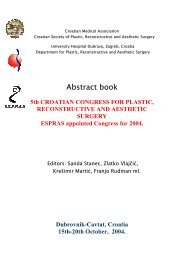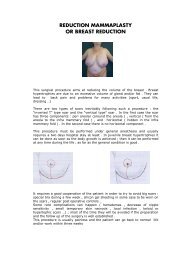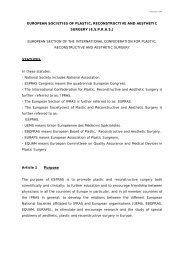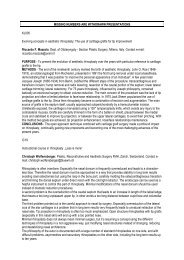Abstract book - ESPRAS
Abstract book - ESPRAS
Abstract book - ESPRAS
You also want an ePaper? Increase the reach of your titles
YUMPU automatically turns print PDFs into web optimized ePapers that Google loves.
P 4. Dilemas about diagnosis and treatment of melanoma in<br />
our clinical material<br />
Arifi H., Zatriqi V., Buja Z. Berisha A.<br />
Department for Plastic Surgery, Clinical Center, Priština, Kosovo<br />
Opste je poznato u svetu sto se tice diagnostike te lecenja malignog<br />
melanoma odavno prevazidjeno sto nije slucaj kod nas. Dileme oko<br />
diagnostike i ako u posljednjih petljeca usavarsana,nova spoznanja na polju<br />
diagnostike kao:ELM,DELM,UZV ne invazivne metode,te invazivnih<br />
metoda citoloska punkcija pigmentirane promjene preko identifikaciji i<br />
biopsiju santinel limfnog cfora novije su dostignuca koje kod nas zbog<br />
nedostatka tehnickih uvjeta kao i nedovoljnog profesinalizma pogorsavaju<br />
prognozu malignog melanoma.Pogorsanje prognozi doprinosi i nemogucnost<br />
aplikaciji jedinstvenog protokola lecenja malignog melanoma.<br />
Cilj rada: nam je da preko nekoliko klinickih slucajeva da prikazeme koje<br />
su najcesce dileme oko diagnostike i lecenja MM na nasem klinickom<br />
materjalu.<br />
Pitanje koje nama kirurzima muci jeste najvise na polju lecenja, sto se tice<br />
kirurskog tipa lecenja ona uklapa u savremene principe dok preostalji dio<br />
koje pripada polji onkologiji ono je kompljetno otpustena na volju samog<br />
pacienta i obitelja pacienata zbog nedostatka onkoloskog instituta oni su<br />
obavezni da ostalji dio lecenja obavljati van zemlje.<br />
P 5. A multicenter study on resorbable craniomaxillofacial<br />
osteofixation<br />
Ashammakhi N. 1,7 , Dominique R. 2 , Arnaud E 2 ., Marchac D. 2 ,<br />
Ninković M. 3 , Donoway D. 4 , Jones B. 4 , Serlo W. 5 , Laurikainen K. 6 ,<br />
Pertti Törmälä 1 , Timo Waris 7<br />
1<br />
Tampere University of Technology, Institute of Biomaterials, Tampere, Finland.<br />
2<br />
Hopital Necker-Enfants Malades, Craniofacial Unit, Paris, France<br />
3<br />
University of Innsbruck, Department of Plastic and Reconstructive Surgery,<br />
Innsbruck, Austria<br />
4<br />
Great Ormond Street Hospital for Sick Children, Craniofacial Unit, London, UK.<br />
5<br />
Oulu University Hospital, Department of Pediatrics, Oulu, Finland<br />
6<br />
Linvatec Ltd., Tampere, Finland<br />
7<br />
Oulu University Hospital, Department of Surgery, Oulu, Finland<br />
Bioabsorbable osteofixation devices were developed to avoid problems<br />
associated with metals. Bioabsorbable devices are mostly made of the<br />
polymers polylactide (PLA), polyglycolide (PGA) and their copolymers<br />
(PLGA and P(L/DL)LA). Using the technique of self-reinforcement of<br />
bioabsorbable materials, it is possible to manufacture osteofixation devices<br />
with ultra high strength. Self-reinforced (SR) polyglycolide-co-polylactide<br />
(SR-PLGA) 80/20 was selected to make devices (Biosorb TM PDX) for this<br />
study because of its favorable degradation characteristics. The aim of this<br />
study was to evaluate the efficacy of using SR-PLGA (Biosorb TM ) plates and<br />
screws in the fixation of osteotomies in craniomaxillofacial (CMF) surgery.<br />
In a prospective study, 165 patients (161 children and 4 adults) were operated<br />
on in four EU centers (Paris, Innsbruck, London and Oulu) from May 1 st ,<br />
1998 to January 31 st , 2002. Indications included correction of dyssynostotic



